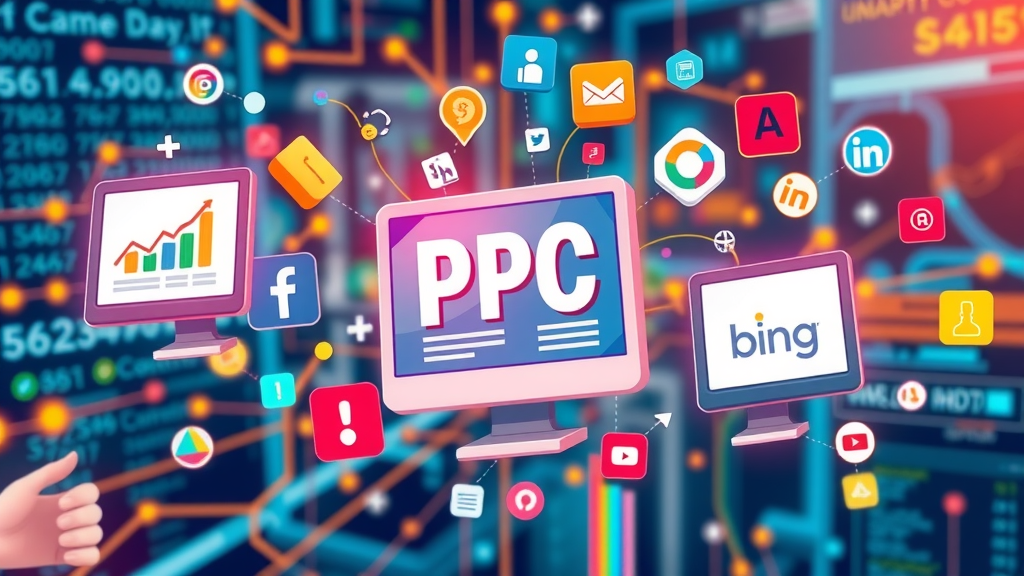Did you know that businesses lose up to 25% of their PPC ad budget to common, avoidable mistakes?
Are you pouring money into PPC ads without seeing results? Avoiding major pay-per-click advertising mistakes can transform your digital marketing outcomes, slash wasted ad spend , and maximize your ROI. In this guide, you'll uncover the biggest errors marketers make, along with clear steps to safeguard your budget and build high-performing ppc campaigns . Whether you're new or experienced, the actionable tips below will help you drive traffic, enhance conversion rates, and escape the pitfalls that sabotage most pay-per-click advertising efforts.
Unlocking the Potential of Pay-Per-Click Advertising: A Must-Know Guide for Marketers
Pay-per-click advertising is a cornerstone of modern digital marketing, but getting it right requires more than just launching a few ppc ads . By understanding how cost per click works and recognizing the avoidable mistakes that drain budgets, marketers can develop high-return strategies and outpace their competition. This section will take you through the vital concepts and practical fixes needed to optimize every advertising campaign .
- The definition and fundamentals of pay-per-click advertising
- The consequences of common PPC advertising mistakes
- Proven strategies to maximize your cost per click ROI
- Best practices for creating high-performing PPC campaigns
- Examples and actionable tips to avoid budget wastage

Understanding Pay-Per-Click Advertising and Its Impact
Defining Pay-Per-Click Advertising and Why It Matters
Pay-per-click advertising is a digital advertising model where the advertiser pays a set fee each time their ad is clicked by a user. Commonly featured across search engines like Google and Bing, as well as major social media platforms like Facebook and LinkedIn, PPC offers instant visibility on competitive engine results pages . This paid search model means advertisers only pay when someone takes action, making cost control and performance measurement more straightforward than traditional online advertising .
Why does PPC matter so much in digital marketing ? It provides marketers with unmatched control, allowing for real-time refinement of ad campaigns , precise targeting of customer segments, and detailed analysis of metrics such as click-through rate (CTR) , conversion rates, and cost per click . Well-planned PPC ads can place your business at the top of the search engine results page (SERP) , boost brand awareness, and drive qualified traffic straight to your landing page—often within hours.
What is pay-per-click advertising? In practice, this advertising model means companies bid for ad placement in search engine results for specific keywords. When users enter relevant search terms, the highest bidders with the most relevant ads (as determined by factors like Quality Score ) are displayed.
| Platform | Ad Type | Average Cost Per Click | Main Benefit |
|---|---|---|---|
| Google Ads | Search & Display | $1 - $2 | Largest reach, robust targeting |
| Bing Ads | Search | $1.54 | Less competition, lower cost |
| Facebook Ads | Display | $0.97 | Highly granular audience targeting |
| LinkedIn Ads | Display | $5.26 | B2B opportunities |

Spotlight on the Biggest Pay-Per-Click Advertising Mistakes to Avoid
Many marketers unknowingly make costly errors that undermine their PPC advertising campaigns. These mistakes—ranging from neglecting detailed keyword research to ignoring Quality Score and forgetting to update negative keywords—can lead to wasted ad spend and missed opportunities. Focusing on the following areas will help you make your pay-per-click advertising budget work harder for you.
- Neglecting keyword research
- Targeting the wrong audience
- Ignoring Quality Score
- Overlooking negative keywords
- Setting and forgetting PPC campaigns
- Unoptimized PPC ad copy
- Poor budget and bid management
By proactively countering these problems, you can create ppc ads that deliver stronger results and ensure every ad campaign is both measurable and scalable.
The Cost of Ignoring Cost Per Click in Pay-Per-Click Advertising
How Cost Per Click Influences PPC Advertising Performance
Cost per click (CPC) is a pivotal metric for every effective ppc campaign . It determines not only how much you spend on each click but also impacts your overall ROI. If CPC is too high, your budget drains without enough conversions; if it’s too low, you risk losing prime ad placement and visibility on the search engine results page . Monitoring, analyzing, and adjusting your CPC bid strategies is crucial for striking the right balance between campaign reach and budget efficiency.
Savvy marketers constantly evaluate their ppc advertising costs in conjunction with conversion rates. This means digging into reports to discover which ads, keywords, or channels have escalating CPC without delivering return. By optimizing bids, removing underperforming keywords, and focusing on high-intent, low-cost alternatives, advertisers can often achieve significantly better results for the same spend—or even cut budgets without sacrificing leads.

PPC Ad Examples: What Works and What to Avoid
What is an example of a PPC ad?
A classic example of a ppc ad is the Google ad that appears at the very top of the search engine results page , marked with the label ‘Ad.’ These positions are awarded through a mix of keyword bidding and relevance, determined by Google’s algorithm and the advertiser’s Quality Score . Other examples include display ads retargeting visitors across the Google Display Network , as well as promoted listings on social media .
The effectiveness of these paid search placements depends on how tightly the ad aligns with user intent and the chosen keywords. Well-crafted ads feature a strong call to action, use clear, relevant copy, and link directly to an optimized landing page . Weak examples—those with generic language, mismatched landing experiences, or misleading calls—quickly burn through budgets while delivering disappointing leads.

Effective Keyword Research in Pay-Per-Click Advertising
The Impact of Keyword Selection on PPC Ads
Keyword research forms the foundation of a successful ppc campaign . When marketers neglect in-depth research or settle for overly broad keywords, they end up attracting irrelevant clicks, driving up cost per click , and reducing overall ROI. On the flip side, pursuing high-intent, long-tail keywords and maintaining a robust list of negative keywords can lower costs and connect your ads with users who are ready to convert.
Missing important negative keywords means your ads might show for unrelated search terms , resulting in wasted ad spend . Regularly updating your keyword lists and keeping pace with search trends, seasonal changes, and shifting buyer intent is mandatory for performance-driven marketers. Leveraging modern research tools and competitive analysis ensures your ppc ads draw in only the most valuable prospects.
- Use tools like Google Keyword Planner
- Focus on high intent, low competition keywords
- Regularly update your negative keyword list

Maximizing Quality Score: The Secret to Smarter Pay-Per-Click Advertising
Why Quality Score Is Essential for PPC Advertising
Quality Score is a vital metric in ppc advertising ; it evaluates the relevance and quality of your keywords, ad copy, landing page experience, and expected CTR. A high Quality Score lowers your cost per click and boosts your ad rank , making it possible to achieve prominent ad placement with less spend on the Google Ads auction.
If you overlook Quality Score , your ppc campaigns may suffer from higher prices, poor visibility, and overall lower returns. Focusing on continuous improvement in this area is a must for sustainable PPC performance.
"A one-point increase in Quality Score can cut your cost per click by up to 30%." – Digital Marketing Institute
Steps to Improve Quality Score
- Optimize landing page relevance
- Craft compelling ad copy
- Refine your keyword targeting
Mastering Google Ads and PPC Advertising Platforms
Key Features of Google Ad and Other PPC Campaign Tools
Google Ads remains the number one choice for most pay-per-click advertising efforts, thanks to its extensive reach and advanced features. However, forward-thinking marketers combine platforms—like Microsoft Ads and Facebook Ads—to diversify their traffic sources and reach untapped segments. Each platform offers unique strengths, such as more granular targeting or lower average cost per click .
Expanding beyond Google also helps mitigate risks associated with depending too heavily on one channel, and enables you to capitalize on niche audiences through platform-specific ad formats and segmentation options.
- Google Ads: Advanced bidding and targeting options
- Microsoft Ads: Lower CPC and competition
- Facebook Ads: Sophisticated audience segmentation
Optimizing Your PPC Ad Copy for Pay-Per-Click Advertising Success
How Unoptimized Ad Copy Drains Your Budget
PPC ad copy is more than just a call to action—it's how you communicate relevance, benefits, and urgency to your best prospects. Weak, mismatched, or unfocused copy contributes to low CTR and high cost per click , particularly when your messaging doesn’t reflect the user’s intent or match the keyword trigger.
The most performant PPC campaigns feature tailored copy that resonates with the target audience, incorporates dynamic keyword insertion, and motivates action. Always test multiple ad variants, hone your value proposition, and connect ad themes to landing page content for digital marketing synergy.
- Use strong calls to action
- Highlight unique selling propositions
- Utilize dynamic keyword insertion

Paid Search and Negative Keywords: Advanced Strategies in Pay-Per-Click Advertising
How to Leverage Negative Keywords for Improved PPC Ads
Negative keywords are crucial in paid search advertising. By specifying words and phrases you don't want to trigger your ppc ads , you can block irrelevant impressions and prevent wasted ad spend on clicks that don’t convert. This discipline is especially valuable in competitive verticals, where singular broad queries can quickly consume a daily budget.
Routine reviews of your search term reports, followed by the addition of new negative keywords, lead to leaner, more effective campaigns with a lower cost per click . This strategy also contributes to a higher Quality Score by improving relevance, thus enhancing your ad rank and placement for valuable search terms.
Budget and Bid Management in Pay-Per-Click Advertising
Achieving Balance: Smart Bidding in PPC Campaigns
Effective budget and bid management is the backbone of successful ppc campaigns . Instead of "set and forget," advertisers should routinely review campaign performance, adjust bids, and reallocate funds as market dynamics shift. Automated bidding strategies—driven by artificial intelligence and real-time data—can simplify management for larger programs but must be monitored for cost efficiency.
Striking a balance between manual control and automation provides the flexibility to quickly adapt to new trends, optimize ad spend , and maximize return on every dollar. Always prioritize bids for high-converting, low-cost keywords, and reduce investment in those delivering diminishing returns.
| Bidding Strategy | Best For | Pros | Cons |
|---|---|---|---|
| Manual CPC Bidding | Experienced managers | Precise control | Time-consuming |
| Automated Bidding | Beginners/large budgets | Saves time, uses AI | Less granular control |
| Enhanced CPC | Conversion-focused | Balances volume and cost | Requires conversion tracking |

Measuring the Success of Pay-Per-Click Advertising
Track Key Metrics: Conversions, ROI & More
To truly assess the effectiveness of your pay-per-click advertising , tracking performance metrics is essential. Key indicators like click-through rate (CTR) , cost per click , conversion rate , and ROI offer a data-driven snapshot of what's working and what's not. Regularly reviewing your performance dashboards ensures you spot emerging trends, uncover areas for improvement, and make impactful adjustments on the fly.
Integrating analytics with your ad campaigns provides a clear pathway to maximizing returns and scaling the campaigns that drive your business objectives. Always use a combination of metrics rather than fixating on a single KPI to make more informed and sustainable decisions.

How Effective is Pay-Per-Click Advertising?
Pay-per-click advertising can be incredibly effective when managed strategically. It provides instant visibility, real-time analytics, and the ability to tightly control every variable in your digital marketing mix. When best practices are consistently applied, advertisers can quickly scale campaigns, generate high-quality leads, and measurably increase sales.
The ability to adjust targeting, copy, and bids based on direct performance feedback is a major advantage over traditional advertising models, leading to optimized outcomes and superior ROI.
Real-World PPC Campaign Case Studies: Lessons from Success and Failure
What Can We Learn From Failed Pay-Per-Click Advertising Campaigns?
Failed ppc campaigns are more common than most marketers admit. Misaligned keywords, lackluster ad copy, or letting budgets run without oversight often doom even the most promising strategies. By analyzing what went wrong—such as bidding on overly generic terms, missing vital negative keywords, or sending users to irrelevant landing pages —you can proactively identify and fix similar issues in your own campaigns.
The key takeaway is the importance of vigilance and adaptation. Constantly refine your approach based on granular analytics to avoid repeating common missteps.
Case Study: Leveraging Quality Score for Cost Per Click Reduction
A regional retailer recently revamped their entire ppc advertising strategy by prioritizing Quality Score improvements. Using more relevant keyword groupings, tightening ad copy, and aligning each ad group with custom-tailored landing pages , they observed a significant reduction in cost per click —by as much as 35% in a single quarter.
This demonstrates how direct action on ad quality and relevance can yield dramatic, fast improvements for campaigns of any size.
Can You Make Money on Pay-Per-Click Ads?
Yes— pay-per-click advertising remains a reliable way for businesses of all sizes to make money online. The key is to avoid costly errors—like mismanagement of bids and neglecting negative keywords—while concentrating on strategies that increase conversion rates . When campaigns are optimized for both relevance and budget, generating a positive ROI becomes an achievable, repeatable result.
Consistently monitoring and improving your ppc ad structure, ad copy, and audience targeting unlocks revenue and keeps your digital marketing investment on a growth trajectory.
Frequently Asked Questions on Pay-Per-Click Advertising
- What is pay-per-click advertising?
- What is an example of a PPC ad?
- Can you make money on pay-per-click ads?
- How effective is pay-per-click advertising?
- How do I choose the right keywords for my PPC ads?
- What is the best way to improve my Quality Score?
- How can I lower my cost per click in digital marketing?
Expert Advice: Digital Marketing Quotes on Pay-Per-Click Advertising
"PPC advertising isn’t about having the biggest budget, it’s about making every click count." – SEMrush Editorial Team
How to Audit Your Pay-Per-Click Advertising Campaigns for Maximum Results
- Review keyword reports and search term triggers
- Assess Quality Score on ad groups and keywords
- Monitor and pause underperforming PPC ads
- Adjust bidding strategies according to market trends
Watch our expert breakdown of costly mistakes in pay-per-click advertising and actionable solutions.
Insightful tutorial covering top PPC advertising tips and what sets successful campaigns apart.
Key Actions to Improve Your Pay-Per-Click Advertising Starting Today
- Audit your current PPC ad campaigns for gaps
- Prioritize ongoing keyword research and optimization
- Implement regular A/B testing for ad copy
- Refine negative keyword lists monthly
People Also Ask: Essential Pay-Per-Click Advertising Questions
What is pay-per-click advertising?
Pay-per-click advertising is a form of online marketing where advertisers pay each time a user clicks their ad. This approach, typically seen on search engines and social media platforms, enables laser-focused targeting and easy tracking of campaign effectiveness, making it a popular choice for driving immediate results.
What is an example of a PPC ad?
On Google, an example of a ppc ad appears above organic listings, clearly labeled as ‘Ad’. These top paid search positions are won by targeting competitive keywords and optimizing for relevance and user intent.
Can you make money on pay-per-click ads?
Absolutely. With a sound pay-per-click advertising strategy, businesses can drive high-quality leads to their landing pages and achieve a strong ROI. The key is continuous optimization and careful budget oversight.
How effective is pay-per-click advertising?
PPC advertising is highly effective for rapid visibility and lead generation. When executed with best practices—like negative keyword optimization and bid management—it can drive measurable and scalable business growth.
Summary: Avoiding Pay-Per-Click Advertising Mistakes and Maximizing Your Digital Marketing ROI
Ready to grow your business? Book your free marketing strategy session with our Team at (864) 535 6456
 Add Row
Add Row  Add
Add 


Write A Comment